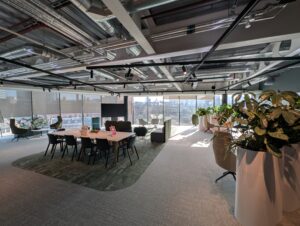Is any item more symbolic of our modern, disposable culture than the single-use coffee cup?
In March 2016, they were vilified in celebrity chef Hugh Fearnley-Whittingstall’s ‘War on Waste’ campaign, when he drove a bus through London covered in 10,000 coffee cups: the number the UK allegedly uses every two minutes.
Thanks to a thin plastic lining that makes them waterproof, most paper recycling mills can’t efficiently process these coffee cups, and the majority are incinerated or sent to landfill. Even worse, they are typically made using virgin tree fibre rather than recycled paper, due to hygiene and food-contact requirements.
Although Fearnley-Whittingstall’s campaign got many people outraged, our drinking habits haven’t slowed since: the number of coffee shops in the UK is projected to grow from 20,000 to 30,000 by 2025. This isn’t necessarily a bad thing, since the industry provides jobs, helps to preserve high streets, and sustains coffee growers in developing countries. But if coffee shops are here to stay, what is the best way to deal with the mountain of waste they generate?
Surge in popularity
According to the waste hierarchy, preventing waste should be the first priority. Reusable cups have surged in popularity and most major coffee shops offer a discount for customers that bring their own (often worth far more than the disposable cup itself). Nevertheless, reusable cups typically make less than 5% of sales.
The unavoidable truth is that it simply isn’t convenient for people on the run to remember their cup, carry it around and wash it out between uses. What’s more, it can take between 20 and 100 uses for a reusable cup to offset its higher greenhouse gas emissions compared to a disposable, due to the greater amount of energy and material required to make a durable product and the hot water needed to wash them.
Compostable coffee cups can seem an attractive alternative since in theory they can leave no harmful residues or litter. But they only break down in industrial composting facilities along with collected food waste, and need dedicated collection streams free from non-compostable materials.
With a bit of planning they can work, as demonstrated in the London 2012 Olympic Games, but at the moment the UK is not set up to deal with compostable packaging. For now, they are best suited to closed environments such as canteens or tourist attractions where they are the only type of packaging used.
It seems the disposable paper cup is here to stay for the foreseeable future.
But things may not be as bad as they seem – even before Fearnley-Whittingstall raised the issue, major stakeholders across the coffee cup value chain, from paper cup manufacturers to coffee chains to waste processors, had come together to form the Paper Cup Recovery and Recycling Group (PCRRG). They realised that the virgin paper fibres used in each cup could be a valuable resource, if only the plastic lining could be removed.
Future tech
The technology already exists, originally developed to recycle Tetra Pak-style liquid cartons.
Essentially the cartons (or cups) are mixed with water and pulped for 20 minutes in a giant washing machine, which allows the plastic lining to be separated. The paper fibres are used again, while the plastic is recycled in garden furniture or building materials.
Currently, three such plants in the UK accept coffee cups: combined, these have the capacity to recycle more than 4.5 billion cups each year – well above the estimated 2.5 billion the UK consumes each year (and that’s without displacing juice cartons and other uses).
But even if the capacity is there, the collection infrastructure and economics also have to work.
In a show of corporate social responsibility, most major chains will now accept any used cup for recycling, even if it was bought elsewhere. What’s more, Costa Coffee even pays a £70 supplement to waste collectors for each tonne of coffee cups recycled, increasing its value by 150% and providing an economic incentive to divert them from landfill.
New end markets are also increasing the demand for recycled coffee cups: Selfridges, for instance, is now ‘upcycling’ coffee cups to make its distinct yellow bags. Already this approach has made great progress, with the number of coffee cups being recycled jumping from one in 400 in 2016 to one in 25 in 2018.
But even recycling isn’t perfect – it consumes a lot of energy, generates greenhouse gas emissions through transporting the cups to the correct facility and can be inefficient due to contamination from incorrect disposal. Once you take into account all the environmental costs incurred throughout a coffee cup’s production, use and disposal, it may be a better option in some areas to take used cups to a local energy-for-waste plant rather than transporting them long distances to be recycled.
Sustainable solutions
The search is on for an even more sustainable solution. For instance a company called Cupffee has launched a coffee cup made of an edible wafer biscuit.
But it is worth remembering that coffee cups still only make up around 0.7% of UK packaging waste. And it’s estimated that packaging makes up less than 5% of the total carbon footprint of a takeaway latte in a disposable cup (consider: the oil used in fertiliser on the plantation, the jet fuel used to transport the coffee beans, the energy used to heat the coffee, and so on). There is a danger that their prominence could take the focus off bigger problems.
In the meantime, why not resolve to rediscover the delight of dining in, with a proper china cup? And should you come across an abandoned coffee cup, you can do your good deed for the day and take it to the nearest collection point.
This article is republished from The Conversation under a Creative Commons license. Read the original article here.














But even recycling isn’t perfect – it consumes a lot of energy, generates greenhouse gas emissions through transporting the cups to the correct facility and can be inefficient due to contamination from incorrect disposal. Once you take into account all the environmental costs incurred throughout a coffee cup’s production, use and disposal, it may be a better option in some areas to take used cups to a local energy-for-waste plant rather than transporting them long distances to be recycled.